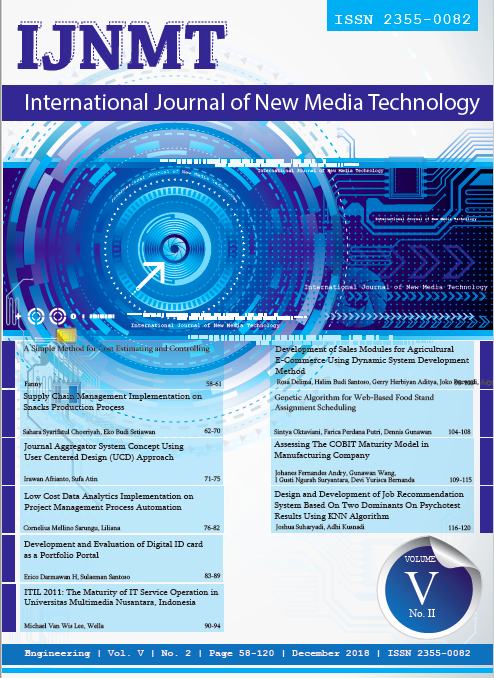Assessing The COBIT Maturity Model in Manufacturing Company
DOI:
https://doi.org/10.31937/ijnmt.v5i2.927Abstract
PT Hema Indonesia is manufacturing company established in 2001 and has continued to grow. Nowadays the company has supported business processes in various companies, such as the use of information systems. The purpose of this research is to get an overview of the performance of information systems in order to determine the extent of maturity level which is currently running, with a few aspects to consider such as effectiveness and, efficiency. Implementing IT governance, however, is a challenge to organizations. To ensure IT alignment with business goals use standard COBIT. The analytical tool used is the standard procedure COBIT issued by ISACA. In this paper the method to be used is COBIT 4.1. Coverage of Audit IT Domain are Plan Organize (PO), such as PO4, PO5, PO7 and PO8. The conclusion that can be drawn from the research that has been done is IT governance at the company has been done, although still run optimally within each IT process contained in the sub domain average on level repeatable and defined proses.
Downloads
Downloads
Published
How to Cite
Issue
Section
License
Authors retain copyright and grant the journal right of first publication with the work simultaneously licensed under a Creative Commons Attribution-ShareAlike International License (CC-BY-SA 4.0) that allows others to share the work with an acknowledgement of the work's authorship and initial publication in this journal.
Authors are able to enter into separate, additional contractual arrangements for the non-exclusive distribution of the journal's published version of the work (e.g., post it to an institutional repository or publish it in a book), with an acknowledgement of its initial publication in this journal.
Copyright without Restrictions
The journal allows the author(s) to hold the copyright without restrictions and will retain publishing rights without restrictions.
The submitted papers are assumed to contain no proprietary material unprotected by patent or patent application; responsibility for technical content and for protection of proprietary material rests solely with the author(s) and their organizations and is not the responsibility of the IJNMT or its Editorial Staff. The main (first/corresponding) author is responsible for ensuring that the article has been seen and approved by all the other authors. It is the responsibility of the author to obtain all necessary copyright release permissions for the use of any copyrighted materials in the manuscript prior to the submission.















